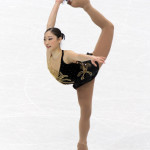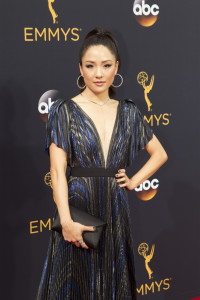
Mirai Nagasu at the 2010 Olympics. Nagasu was one of 11 Asian Americans representing the U.S. in the winter 2018 Olympics.
This 2018 Winter Olympics has been an amazing time for the Asian Americans on the U.S. team.
In snowboarding, Chloe Kim at 17 years old became the youngest female to win a medal, taking gold.
Vincent Zhou became the first skater to land a quadruple lutz jump in any Olympic game ever.
Nathan Chen became the first skater to attempt and land six quadruple jumps in one program, and Mirai Nagasu became the first American female figure skater to land a triple axel in the Olympics and the third in the world.
Siblings Maia and Alex Shibutani took bronze in the ice dance event.
Of the 14 U.S. figure skaters, half were Asian American: Karen Chen, Nathan Chen, Madison Chock, Mirai Nagasu, Vincent Zhou, and Alex and Maia Shibutani. Other Asian Americans in the Olympics include snowboarders Hailey Langland and Chloe Kim, and short track speed-skaters J.R. Celski, Thomas Hong and Aaron Tran. In the Paralympics, Jen Lee will compete in the sled hockey section. Because I couldn’t find statistics regarding race and representation on the Paralympics website, it was difficult to determine exactly how people identify.
It’s so good to see Asian Americans making and taking that space in events that are normally, and still, dominated by white Americans. It feels so good to know that there are more role models for children in America, that they know they can do whatever they want. When there are only 11 Asian Americans in the Olympics out of 244 athletes, around 4.5 percent, and one out of 49 is about 2 percent in the Paralympics, its says something about the access and the systems in place.
In the past, it has been leaders like Michelle Kwan, Apolo Ohno and Kristi Yamaguchi that pushed ahead to show kids that they too could be on the Olympic stage.
“I’m super proud to be part of the Asian American heritage who is here representing the U.S.,” Nagasu said in a USA Today video.
The video focuses on the skaters, their familial backgrounds and their performances in the Olympics. Some are second generation, the children of immigrants. Clips of Zhou, Nagasu and Nathan Chen talking about their heritage are included in the video.
“They had to work for everything, couldn’t take anything for granted, and they transferred those values to me,” Zhou said. “Hard work, integrity, humility: those are some of the things that almost every Asian-American athlete has, and we’re all very proud of it.”
Some have a different story, like the Shibutanis, whose grandparents were American citizens working in Japan when their mother was born in Tokyo. When she was a toddler, they moved back to the U.S. and later she met Maia and Alex’s father at college.
Celski’s mother is first generation Filipino American, his father of Polish ancestry. The varied stories and backgrounds of the Asian Americans in the Olympics reflects the many stories of Asian Americans all across America. Some of these athletes trace their ancestry back to Japan, some to Korea, some to China (and Taiwan), the Philippines, Vietnam. And some can trace their ancestry back to Poland, Ireland, to Hawaii as well. There is no one Asian-American narrative.
Recently, a question has become more and more pressing: are the Olympics still relevant? Many cities don’t want to host the Olympics, citing citizen disapproval, increased traffic and wear and tear on the stadiums, according to PopZette. Television ratings have gone down, and in the events themselves you can see that the stands are not always filled. For the first time since the Olympics opened in 1894, figure skaters can skate to music with lyrics, a move supposedly used to appeal to younger audiences.
I would answer YES, the Olympics are still relevant. In light of the Larry Nassar scandal, taking a look at the representation in the Olympic teams, and thinking of the access children need in order to become the athletes they see in the Olympics, I’d say there are many things that definitely need to change.
While Asian American representation in the Olympics is rising, there’s still a long way to go — not just for Asian Americans, but for people of color in general. This has been one of the most diverse Olympics yet, with 10 African Americans and 11 Asian Americans, which, let’s be honest, is not very many, so let’s keep going. On a side-note about representation, Adam Rippon and Gus Kenworthy have also made history by becoming the first openly gay athletes to represent the U.S. in the Winter Olympics!
When there are movements like #thisis2016, an outpouring of Asian Americans revealing the racism and prejudice they encountered even in the supposedly “post-racial,” “colorblind” America of the Obama-era, when there are still incidents like the one on February 17, where a Taco Bell employee gave an Asian American customer a receipt that had printed a racial slur on it, when Asian Americans are still seen as ‘other,’ and when after Nagasu landed the triple axel a reporter from the NYT tweeted a supposedly misunderstood ‘Immigrants, they get the job done’ even though Nagasu was born and raised in California, it means that we must realize the importance of representation and keep pushing forward. We must celebrate ourselves and other people of color.
Most importantly, we must remember that in addition to being incredible athletes, just their existence on those podiums, in front of those cameras, on that ice, that slope, their presence in that arena, is also a statement.


